Spatial and Temporal Characteristics and Driving Forces of Vegetation Changes in the Huaihe River Basin from 2003 to 2018
Abstract
1. Introduction
2. Materials and Methods
2.1. Study Area
2.2. Data and Processing
2.2.1. NDVI Data
2.2.2. LST and TRMM Data
2.3. Methods
2.3.1. Mann-Kendall Non-Parametric Significance Test and Theil-Sen Slope Test
2.3.2. Mann–Kendall Mutation Test
2.3.3. Min-Max Normalization
2.3.4. Kurtosis Coefficient and Skewness
3. Results and Discussion
3.1. Analysis of Spatial and Temporal Characteristics of NDVI in the Huaihe River Basin
3.1.1. Spatial Distribution Characteristics of the Annual Mean NDVI Value
3.1.2. Annual NDVImax Time Changes for Different Land Cover Types
3.1.3. Vegetation Change Trend
3.2. Mutation Characteristics of NDVI and Climate Factors in the Huaihe River Basin
3.3. Relationships between NDVI and Climate Factors in the Huaihe River Basin
3.3.1. Fluctuation Characteristics of Time-Series Curves Between NDVI and Climate Factors
3.3.2. Correlations between NDVI and Climate Factors on Different Time Scales
3.3.3. Effects of TRMM and LST on Vegetation Growth
4. Conclusions
Author Contributions
Funding
Acknowledgments
Conflicts of Interest
References
- Sun, H.Y.; Wang, C.Y.; Niu, Z.; Bukhosor, L.B. Analysis of the vegetation cover change and the relationship between NDVI and environmental factors by using NOAA time series data. J. Remote Sens. 1988, 2, 204–210. [Google Scholar]
- Fan, N.; Xie, G.D.; Zhang, C.S.; Chen, L.; Li, W.H.; Cheng, S.K. Spatial-temporal dynamic changes of vegetation cover in Lancang river basin during 2001–2010. Resour. Sci. 2012, 34, 1222–1231. [Google Scholar]
- Yuan, L.H.; Jiang, W.G.; Shen, W.M.; Liu, Y.H.; Wang, W.J.; Tao, L.L.; Zheng, H.; Liu, X.F. The spatio-temporal variations of vegetation cover in the Yellow River Basin from 2000 to 2010. Acta Ecol. Sin. 2013, 33, 7798–7806. [Google Scholar]
- Myneni, R.B.; Keeling, C.D.; Tucker, C.J.; Asrar, G.; Nemani, R.R. Increased plant growth in the northern high latitudes from 1981 to 1991. Nature 1997, 386, 698–702. [Google Scholar] [CrossRef]
- Ma, L.; Yan, H.W.; He, Y.; Zhang, Q.; Liu, B. Vegetation changes in south Himalayas areas based on remote sensing monitoring during 2001–2015. Arid Land Geog. 2017, 40, 405–414. [Google Scholar]
- Fang, J.Y.; Song, Y.C.; Liu, H.Y.; Piao, S.L. Vegetation-climate relationship and its application in the division of vegetation zone in china. Acta Bot. Sin. 2002, 44, 1105–1122. [Google Scholar]
- Fuller, D.O.; Prince, S.D. Rainfall and foliar dynamics in tropical Southern Africa: Potential impacts of global climatic change on savanna vegetation. Clim. Chang. 1996, 33, 69–96. [Google Scholar] [CrossRef]
- Kong, D.; Zhang, Q.; Singh, V.P.; Shi, P. Seasonal vegetation response to climate change in the northern hemisphere (1982–2013). Glob. Planet. Chang. 2017, 148, S0921818116302260. [Google Scholar] [CrossRef]
- Fensholt, R.; Rasmussen, K.; Nielsen, T.; Mbow, C. Evaluation of earth observation based long term vegetation trends Intercomparing NDVI time series trend analysis consistency of Sahel from AVHRR GIMMS, Terra MODIS and SPOTVGT data. Remote Sens. Environ. 2009, 113, 1886–1898. [Google Scholar] [CrossRef]
- Fensholt, R.; Proud, S.R. Evaluation of earth observation based global long term vegetation trends comparing GIMMS and MODIS global NDVI time series. Remote Sens. Environ. 2012, 119, 131–147. [Google Scholar] [CrossRef]
- Chen, S.N.; Guo, J. Evaluation of different spatial interpolation methods in regional temperature sequence: A case study in Northeast China. Chin. J. Agrometeorol. 2015, 36, 234–241. [Google Scholar]
- Zhu, H.Y.; Jia, S.F. Uncertainty in the spatial interpolation of rainfall data. Prog. Geog. 2004, 2, 34–42. [Google Scholar]
- Chen, Q.; Chen, Y.H.; Wang, M.J.; Jiang, W.G.; Hou, P.; Li, Y. Change of vegetation net primary productivity in Yellow River watersheds from 2001 to 2010 and its climatic driving factors analysis. Chin. J. Appl. Ecol. 2014, 25, 2811–2818. [Google Scholar]
- Li, H.X.; Liu, G.H.; Fu, B.J. Response of vegetation to climate change and human activity based on NDVI in the Three-River Headwaters region. Acta Ecol. Sin. 2011, 31, 5495–5504. [Google Scholar]
- Qu, S.; Wang, L.; Lin, A.; Zhu, H.; Yuan, M. What drives the vegetation restoration in yangtze river basin, china: climate change or anthropogenic factors? Ecol. Indic. 2018, 90, 438–450. [Google Scholar] [CrossRef]
- Zhou, Y.Y.; Zhu, M.X.; Guo, X.J.; Li, K.; Miao, J.X.; Guo, J.J.; Xu, X.F.; Yue, D.X. Relative effects of climate change and human activities on net primary productivity in Shule River Basin. Acta Ecol. Sin. 2019, 39, 5127–5137. [Google Scholar]
- Xiao, M.Z.; Yu, Z.B.; Zhu, Y.L. Copula-based frequency analysis of drought with identified characteristics in space and time: a case study in Huai River basin, China. Theor. Appl. Climatol. 2019, 137, 2865–2875. [Google Scholar] [CrossRef]
- Wu, Y.N.; Zhong, P.A.; Xu, B.; Zhu, F.L.; Ma, B. Changing of flood risk due to climate and development in Huaihe River basin, China. Stoch. Environ. Res. Risk Assess 2017, 31, 935–938. [Google Scholar] [CrossRef]
- Wang, K.; Chu, D.Y.; Yang, Z.H. Flood Control and Management for the Transitional Huaihe River in China. Procedia Eng. 2016, 154, 703–709. [Google Scholar]
- Qing, W.; Xuehua, L.; Baolei, L. Dynamic changes and spatial patterns of vegetation cover in a river basin based on SPOT-VGT data: A case study in the Huaihe River Basin. Prog. Geogr. 2013, 32, 270–277. [Google Scholar]
- Ren, X.; Zheng, J.H.; Mu, C.; Yan, K.; Xu, T.B. Evaluating reliability of grassland net primary productivity estimates using different meteorological interpolation methods. Pratacult. Sci. 2017, 34, 439–448. [Google Scholar]
- Vicente-Serrano, S.; Saz-Sánchez, M.A.; Cuadrat, J. Comparative analysis of interpolation methods in the Middle Ebro valley (Spain): Application to annual precipitation and temperature. Clim. Res. 2003, 24, 161–180. [Google Scholar] [CrossRef]
- Huaihe River Water Conservancy. Available online: http://www.hrc.gov.cn/main/lyjs.jhtml (accessed on 19 November 2019).
- Zhang, H.B.; Tang, H.J.; Yang, G.X.; Li, G.; Chen, B.R.; Xin, X.P. Changes of spatial-temporal characteristics based on MODIS NDVI data in Inner Mongolia grassland from 2000 to 2008. J. Chin. Soc. Agric. Eng. 2009, 25, 168–175. [Google Scholar]
- Liu, Y.T. Analysis of the Accuracy Evaluation of TRMM Precipitation Data in Henan Province. Master’s Thesis, Henan University, Kaifeng, Henan, China, 2018. [Google Scholar]
- Shiflett, S.A.; Liang, L.L.; Crum, S.M.; Feyisa, G.L.; Wang, J.; Jenerette, G.D. Variation in the urban vegetation, surface temperature, air temperature nexus. Sci. Total Environ. 2017, 579, 495–505. [Google Scholar] [CrossRef]
- Zhao, W.; He, J.L.; Yin, G.F.; Wen, F.P.; Wu, H. Spatiotemporal variability in land surface temperature over the mountainous region affected by the 2008 Wenchuan earthquake From 2000 to 2017. J. Geophys. Res. Atmos. 2019, 124, 1975–1991. [Google Scholar] [CrossRef]
- Zhang, H.Q.; Yang, Y.J.; Xun, S.P.; He, B.F.; Zhang, A.M.; Wu, W.Y. Seasonal and spatial variability of vegetation and land surface temperature in Anhui Province. J. Appl. Meteorol. Sci. 2011, 22, 232–240. [Google Scholar]
- Xu, Z.X.; Liu, L.; Liu, Z.F. Impact of Climate Change on Hydrological Cycle in River Basins; Science Press: Beijing, China, 2015; pp. 15–18. [Google Scholar]
- Gocic, M.; Trajkovic, S. Analysis of changes in meteorological variables using Mann-Kendall and Sen’s slope estimator statistical tests in Serbia. Glob. Planet. Chang. 2013, 100, 172–182. [Google Scholar] [CrossRef]
- Cai, B.F.; Yu, R. Advance and evaluation in the long time series vegetation trends research based on remote sensing. J. Remote Sens. 2009, 13, 1170–1186. [Google Scholar]
- Li, Y.; Xie, Z.; Qin, Y.; Xia, H.; Zheng, Z.; Zhang, L.; Pan, Z.; Liu, Z. Drought under global warming and climate change: An empirical study of the Loess Plateau. Sustainability 2019, 11, 1281. [Google Scholar] [CrossRef]
- Ye, Z.W.; Wu, W. Characteristics of Climate Change and Its Driving Forces in the Tourism Area of Lushan Mountain Since 1955. Sci. Geogr. Sin. 2011, 31, 1221–1227. [Google Scholar]
- Guna, A.; Zhang, J.Q.; Tong, S.Q.; Bao, Y.B.; Han, A.; Li, K.W. Effect of Climate Change on Maize Yield in the Growing Season: A Case Study of the Songliao Plain Maize Belt. Water 2019, 11, 2108. [Google Scholar] [CrossRef]
- Yibin, G.; Chunyan, L.U.; Lianxiu, Z.; Xiaoqing, L.; Ying, S.U. Temporal and spatial characteristics of temperature and precipitation in china′s coastal areas from 1951 to 2016. J. Forest. Environ. 2019, 137, 530–539. [Google Scholar]
- Wang, J.F.; Wu, T.L. Analysis on runoff variation characteristics and its attribution in the upper reaches of Zhanghe river basin. J. Arid Land Resour. Environ. 2019, 33, 165–171. [Google Scholar]
- Faiz, M.A.; Liu, D.; Fu, Q.; Khan, M.I.; Li, T.; Cui, S. Assessment of characteristics and distinguished hydrological periods of a river regime. Environ. Earth Sci. 2018, 77, 7913–7917. [Google Scholar] [CrossRef]
- Huang, Y.; Huang, Z.L.; Xiao, W.F.; Zeng, L.X.; Ma, L. Trend Analysis with Mann-Kendall Test on Water Quality of the Mainstream Inflow and Outflow for the Three Gorges Reservoir of Yangtze River. Resour. Environ. Yangtze Basin 2019, 28, 950–961. [Google Scholar]
- Yu, Z.; Fung, B.C.M.; Haghighat, F.; Yoshino, H.; Morofsky, E. A systematic procedure to study the influence of occupant behavior on building energy consumption. Energy Build. 2011, 43, 1409–1417. [Google Scholar] [CrossRef]
- Chen, M.H.; Chen, Y.B.; Guo, G.H.; Feng, Z.X. Temporal and spatial changes of urban thermal environment and driving mechanism in Dongguan City. Geogr. Res. 2011, 30, 1431–1438. [Google Scholar]
- Liang, J.; Tang, M.L.; Zhao, X. Testing high-dimensional normality based on classical skewness and Kurtosis with a possible small sample size. Commun. Stat. Theory Methods 2019, 48, 5719–5732. [Google Scholar] [CrossRef]
- Wang, X.M. Misunderstanding of the concepts of skewness and kurtosis. Stat. Decis. 2008, 12, 145–146. [Google Scholar]
- Liu, Z.Z.; Zhang, X.W.; Chen, Y.S.; Zhang, C.C.; Qin, F.; Zeng, H.W. Remote sensing estimation of biomass in winter wheat based on CASA model at region scale. Trans. Chin. Soc. Agric. Eng. 2017, 33, 225–233. [Google Scholar]
- Li, X.B.; Chen, Y.H.; Zhang, Y.X.; Fan, Y.D.; Zhou, T.; Xie, F. Impact of climate change on desert steppe in northern China. Adv. Earth Sci. 2002, 17, 254–261. [Google Scholar]
- Xia, M.; Sun, P.; Zhang, Q.; Yao, R.; Wang, Y.Z.; Wen, Q.Z. Temporal and spatial characteristic of drought in Huaihe River Basin based on standardized precipitation evapotranspiration index. Acta Ecol. Sin. 2019, 39, 3643–3654. [Google Scholar]
- Zhang, X.W.; Qin, F. Coupling relationship of precipitation and vegetation and its influence for sediment yield in Pisha sandstone area. Geogr. Res. 2016, 35, 513–524. [Google Scholar]
- Luo, L.S.; Xu, M.; Liang, S.X. Stability analysis of the interannual relationship between El Nino/La Nina and the summer rainfall over Huaihe River basin. Meteorol. Mon. 2018, 44, 1073–1081. [Google Scholar]
- Zhang, W. Spatial and Temporal Variation of Vegetation Phenology and Its Response to Climate Change in Inner Mongolia. Master’s Thesis, Inner Mongolia Normal University, Hohhot, China, 2019; pp. 37–44. [Google Scholar]
- Julien, Y.; Sobrino, J.A.; Mattar, C.; Ruescas, A.B.; Jiménez-Muñoz, J.C.; Sòria, G.; Hidalgo, V.; Atitar, M.; Franch, B.; Cuenca, J. Temporal analysis of normalized difference vegetation index (NDVI) and land surface temperature (LST) parameters to detect changes in the Iberian land cover between 1981 and 2001. Int. J. Remote Sens. 2011, 32, 2057–2068. [Google Scholar] [CrossRef]
- Gu, Z.; Duan, X.; Shi, Y.; Li, Y.; Pan, X. Spatiotemporal variation in vegetation coverage and its response to climatic factors in the Red River Basin, China. Ecol. Indic. 2018, 93, 54–64. [Google Scholar] [CrossRef]
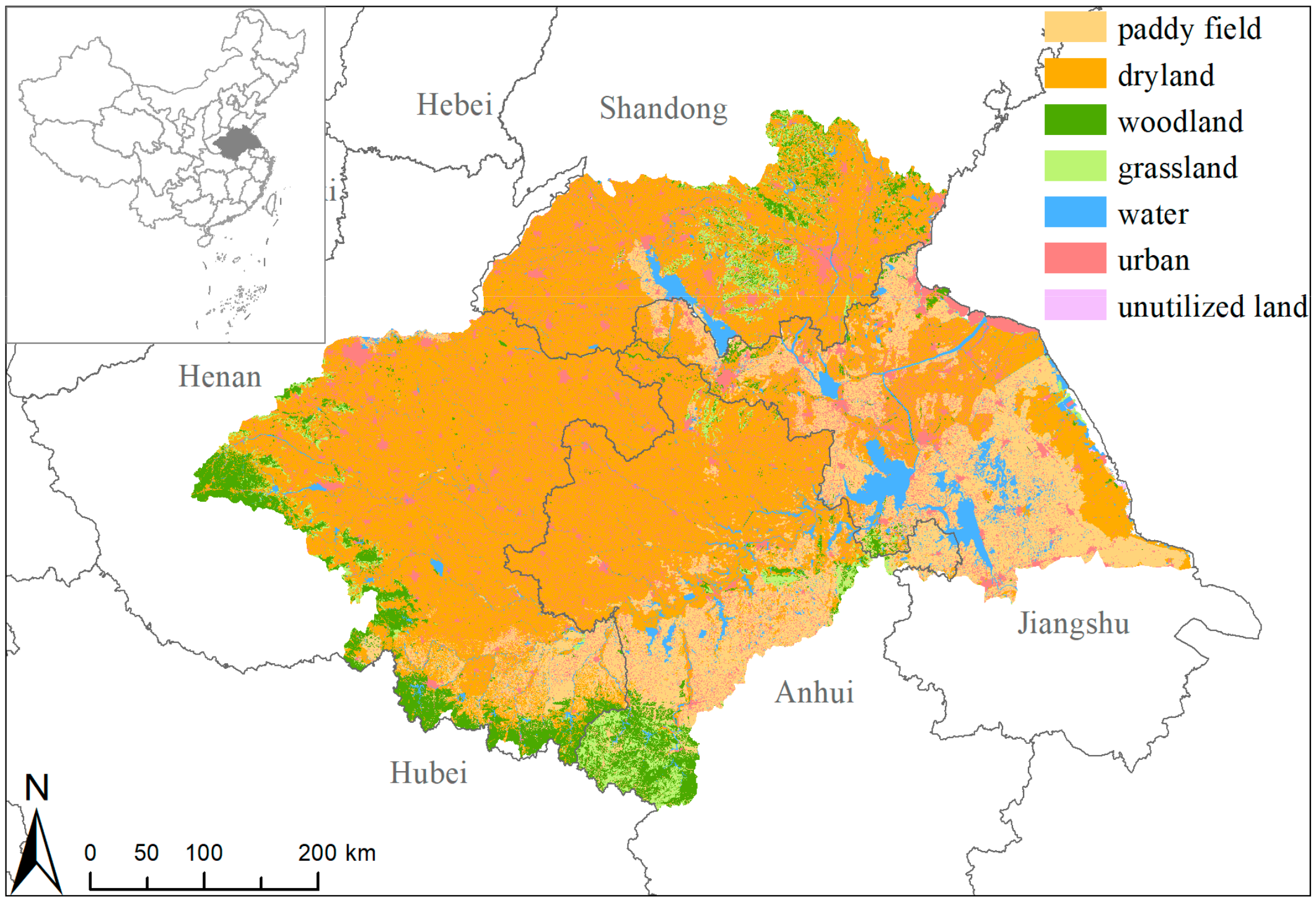


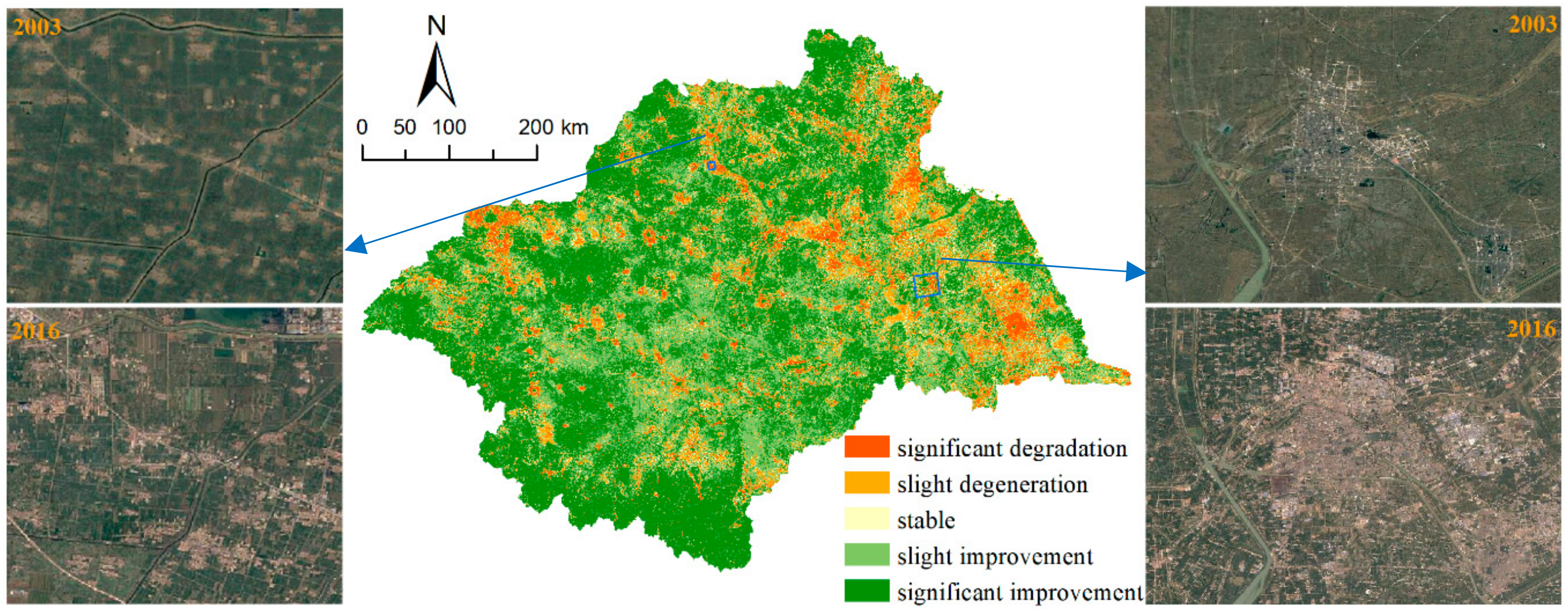
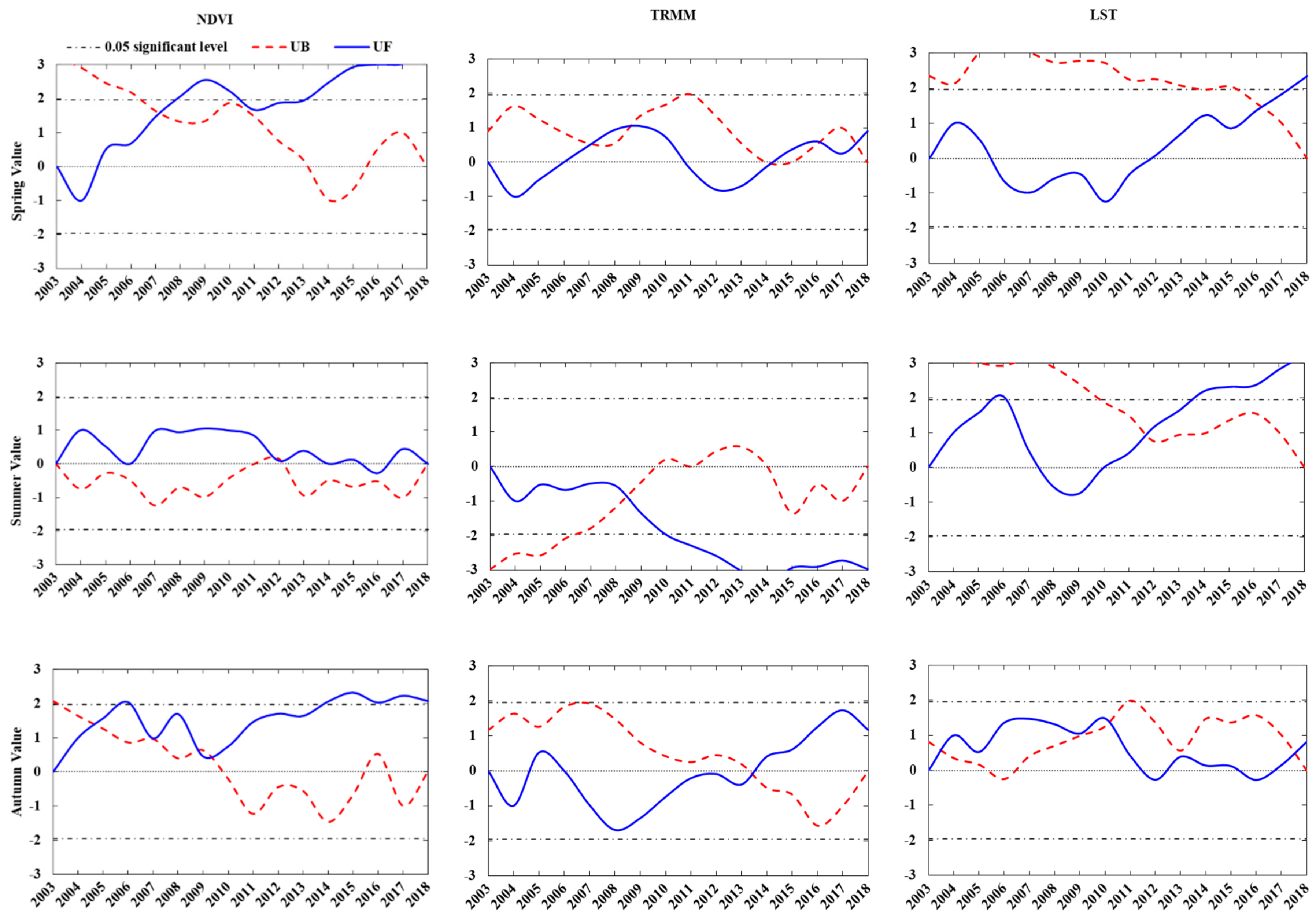
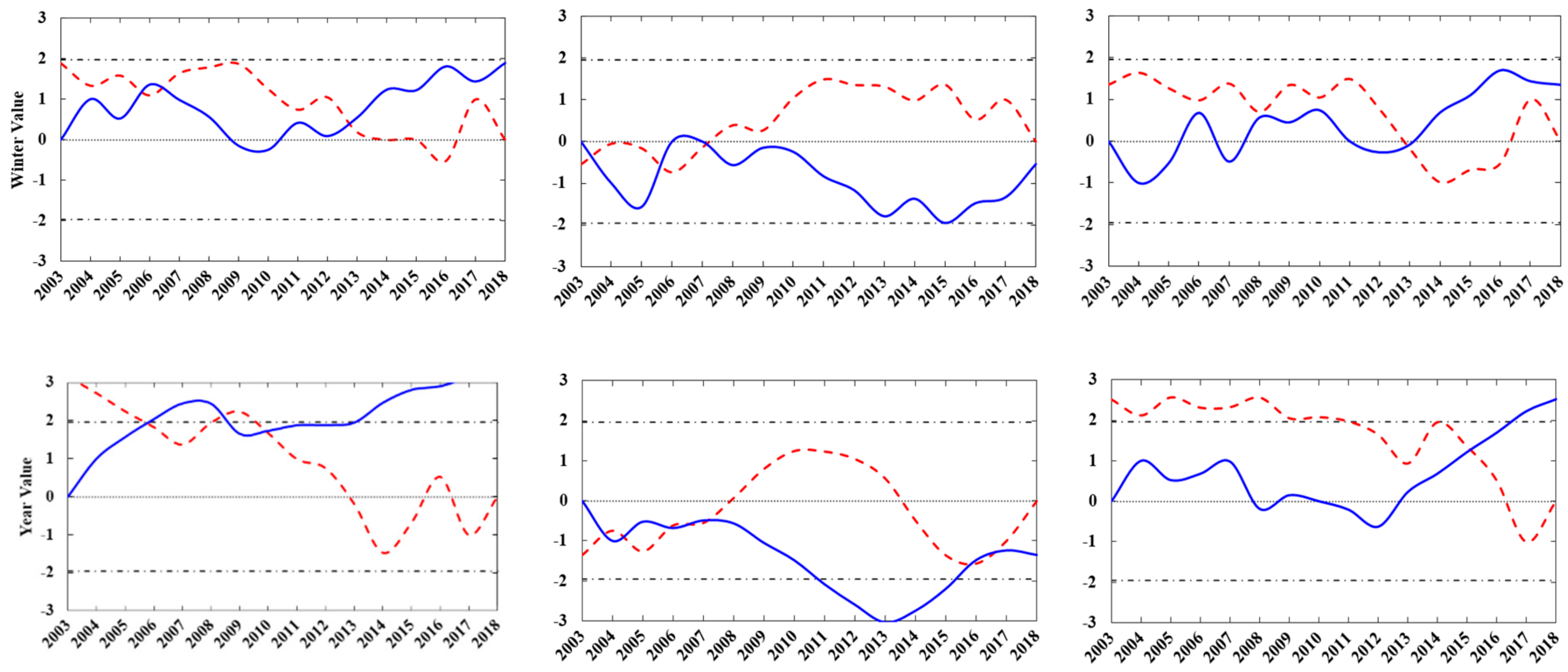

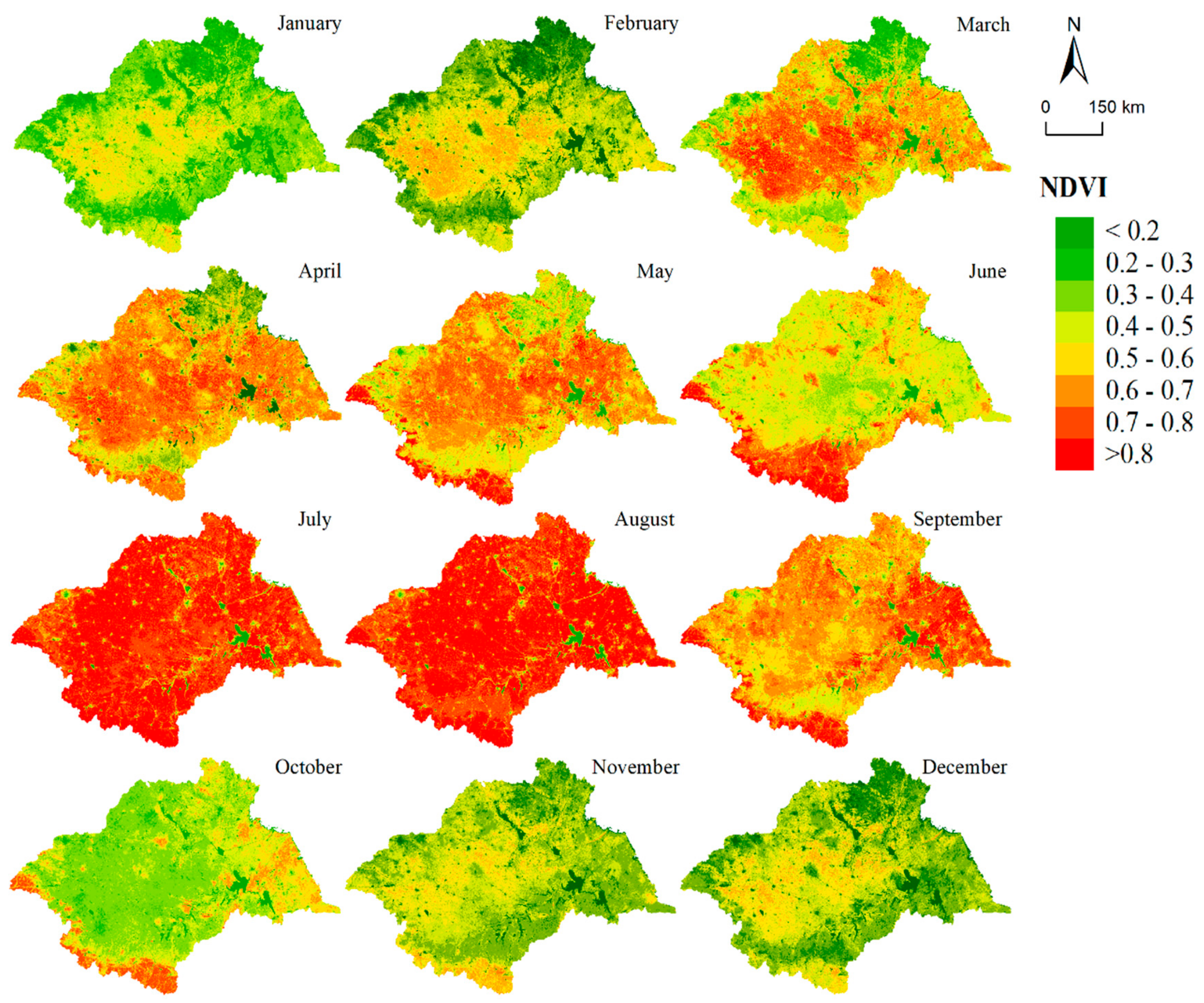
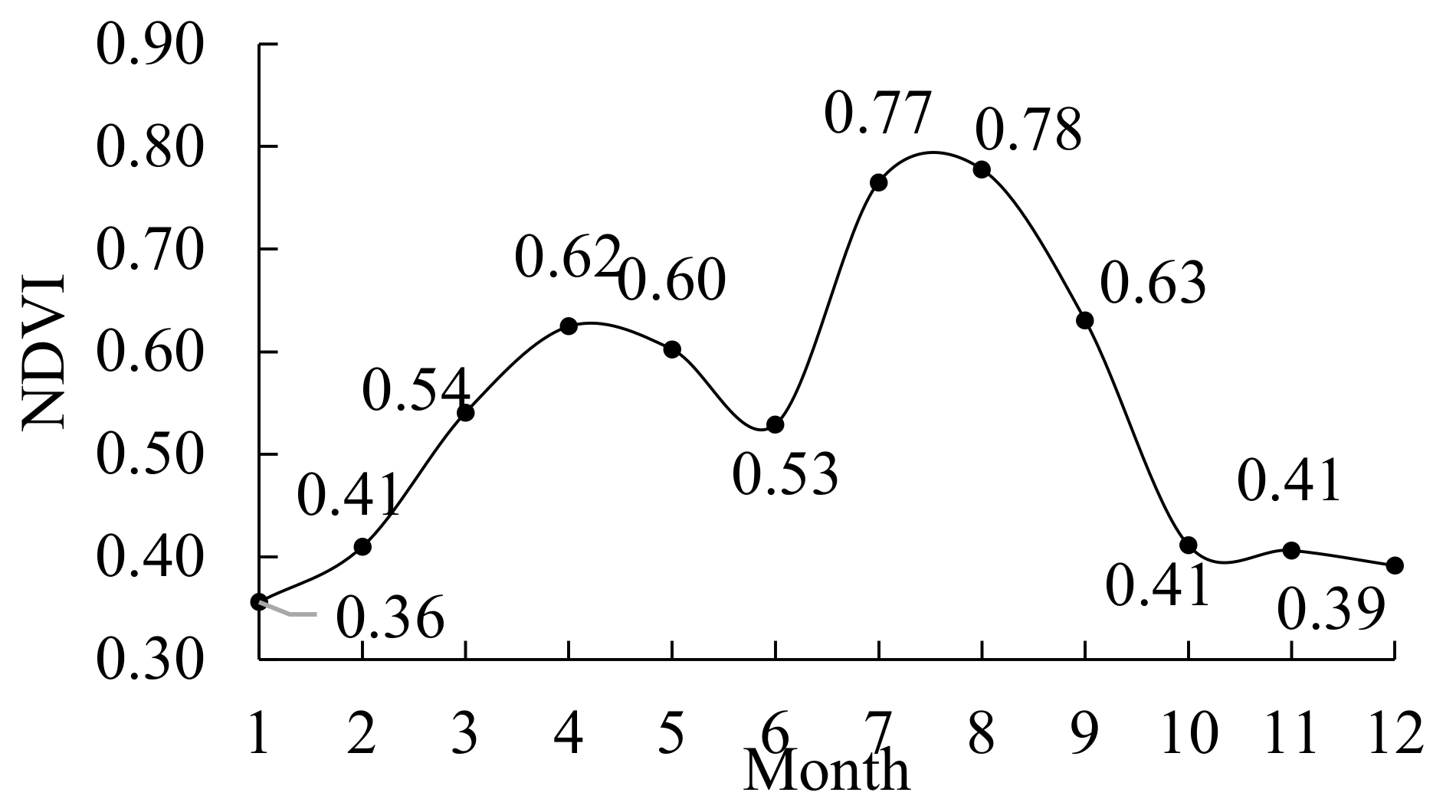


| Type | Maximum Departure Year | Maximum Departure | Minimum Departure Year | Minimum Departure |
|---|---|---|---|---|
| paddy field | 2011 | 0.0226 | 2003 | −0.0297 |
| dryland | 2011 | 0.0256 | 2003 | −0.0323 |
| woodland | 2015 | 0.0240 | 2003 | −0.0312 |
| grassland | 2011 | 0.0200 | 2003 | −0.0354 |
| water | 2011 | 0.0474 | 2003 | −0.0520 |
| urban | 2011 | 0.0331 | 2018 | −0.0239 |
| unutilized land | 2007 | 0.0277 | 2014 | −0.0318 |
| study area | 2011 | 0.0259 | 2003 | −0.0300 |
| β | Z | Pixel Number | Area Percent | Result | β and Z Accuracy |
|---|---|---|---|---|---|
| ≤−0.0005 | ≤−1.96 | 236362 | 5.50% | Significant Degradation | 99.50% |
| ≤−0.0005 | −1.96–1.96 | 474532 | 11.05% | Slight Degeneration | |
| −0.0005–0.0005 | −1.96–1.96 | 265295 | 6.18% | Stable | |
| <−0.0005 | −1.96–1.96 | 1347148 | 31.37% | Slight Improvement | |
| <−0.0005 | <−1.96 | 1970409 | 45.89% | Significant Improvement |
| Spring | Summer | Autumn | Winter | Year(s) | |
|---|---|---|---|---|---|
| NDVI | 2007 | 2012 | 2005/2007/2009 | 2006/2013 | 2006/2008/2010 |
| TRMM | 2007/2009/2014/2016 | 2008 | 2013 | 2006/2007 | 2004/2006/2007/2016 |
| LST | 2016 | 2012 | 2010/2017 | 2013 | 2015 |
| Month | NDVI | TRMM | LST | |
|---|---|---|---|---|
| January | NDVI | 1 | ||
| TRMM | 0.01 | 1 | ||
| LST | 0.30 | −0.56 * | 1 | |
| February | NDVI | 1 | ||
| TRMM | 0 | 1 | ||
| LST | 0.21 | −0.24 | 1 | |
| March | NDVI | 1 | ||
| TRMM | −0.21 | 1 | ||
| LST | 0.53* | −0.46 | 1 | |
| April | NDVI | 1 | ||
| TRMM | 0.28 | 1 | ||
| LST | 0.29 | −0.3 | 1 | |
| May | NDVI | 1 | ||
| TRMM | 0.09 | 1 | ||
| LST | −0.50 * | −0.09 | 1 | |
| June | NDVI | 1 | ||
| TRMM | −0.15 | 1 | ||
| LST | −0.04 | −0.16 | 1 | |
| July | NDVI | 1 | ||
| TRMM | 0.11 | 1 | ||
| LST | −0.42 | −0.78 ** | 1 | |
| August | NDVI | 1 | ||
| TRMM | 0.17 | 1 | ||
| LST | −0.46 | −0.60 * | 1 | |
| September | NDVI | 1 | ||
| TRMM | 0.35 | 1 | ||
| LST | −0.47 | −0.35 | 1 | |
| October | NDVI | 1 | ||
| TRMM | 0.62 ** | 1 | ||
| LST | −0.41 | −0.71 ** | 1 | |
| November | NDVI | 1 | ||
| TRMM | 0.36 | 1 | ||
| LST | −0.1 | −0.43 | 1 | |
| December | NDVI | 1 | ||
| TRMM | 0.13 | 1 | ||
| LST | 0.07 | −0.58 * | 1 |
| Temporal Scale | NDVI | TRMM | LST | |
|---|---|---|---|---|
| Year | NDVI | 1 | ||
| TRMM | −0.33 | 1 | ||
| LST | 0.53 * | −0.25 | 1 | |
| Spring | NDVI | 1 | ||
| TRMM | 0.49 * | 1 | ||
| LST | 0.10 | −0.05* | 1 | |
| Summer | NDVI | 1 | ||
| TRMM | −0.17 | 1 | ||
| LST | −0.07 | −0.66 ** | 1 | |
| Autumn | NDVI | 1 | ||
| TRMM | 0.27 | 1 | ||
| LST | −0.11 | −0.43 | 1 | |
| Winter | NDVI | 1 | ||
| TRMM | 0.22 | 1 | ||
| LST | 0.30 | 0.17 | 1 | |
| Month | NDVI | 1 | ||
| TRMM | 0.88 ** | 1 | ||
| LST | 0.78 ** | 0.79 ** | 1 |
| Range | Paddy Field | Dryland | Woodland | Grassland | Study Area | |
|---|---|---|---|---|---|---|
| TRMM/mm | 606–767 | 0.51 | 0.47 | 0.52 | 0.46 | 0.45 |
| 768–843 | - | 0.55 | 0.55 | - | 0.51 | |
| 844–915 | 0.56 | 0.57 | 0.57 | 0.44 | 0.54 | |
| 916–975 | 0.49 | 0.54 | 0.53 | 0.43 | 0.50 | |
| 976–1,035 | 0.58 | 0.58 | - | - | 0.56 | |
| 1,036–1,092 | 0.59 | 0.59 | 0.59 | 0.54 | 0.57 | |
| 1,093–1,152 | 0.55 | 0.59 | 0.67 | 0.42 | 0.55 | |
| 1,153–1,228 | 0.55 | 0.57 | 0.63 | - | 0.53 | |
| 1,229–1,372 | 0.54 | 0.53 | 0.61 | 0.50 | 0.49 | |
| 1,373–1,629 | 0.51 | - | 0.64 | 0.67 | 0.58 | |
| LST/℃ | 8.0–14.4 | - | - | 0.67 | - | 0.63 |
| 14.5–16.4 | 0.48 | 0.53 | 0.66 | 0.69 | 0.09 | |
| 16.5–17.8 | 0.48 | 0.48 | 0.65 | 0.67 | 0.35 | |
| 17.9–19 | 0.54 | 0.51 | 0.65 | 0.63 | 0.50 | |
| 19.1–19.9 | 0.58 | 0.56 | 0.63 | 0.59 | 0.56 | |
| 20–20.5 | 0.58 | 0.56 | 0.62 | 0.54 | 0.56 | |
| 20.6–21.1 | 0.55 | 0.56 | 0.59 | 0.49 | 0.55 | |
| 21.2–21.7 | 0.52 | 0.56 | 0.55 | 0.48 | 0.54 | |
| 21.8–22.6 | 0.51 | 0.57 | 0.53 | 0.46 | 0.55 | |
| 22.7–24.8 | 0.48 | 0.48 | 0.49 | 0.46 | 0.44 |
© 2020 by the authors. Licensee MDPI, Basel, Switzerland. This article is an open access article distributed under the terms and conditions of the Creative Commons Attribution (CC BY) license (http://creativecommons.org/licenses/by/4.0/).
Share and Cite
Liu, Z.; Wang, H.; Li, N.; Zhu, J.; Pan, Z.; Qin, F. Spatial and Temporal Characteristics and Driving Forces of Vegetation Changes in the Huaihe River Basin from 2003 to 2018. Sustainability 2020, 12, 2198. https://doi.org/10.3390/su12062198
Liu Z, Wang H, Li N, Zhu J, Pan Z, Qin F. Spatial and Temporal Characteristics and Driving Forces of Vegetation Changes in the Huaihe River Basin from 2003 to 2018. Sustainability. 2020; 12(6):2198. https://doi.org/10.3390/su12062198
Chicago/Turabian StyleLiu, Zhenzhen, Hang Wang, Ning Li, Jun Zhu, Ziwu Pan, and Fen Qin. 2020. "Spatial and Temporal Characteristics and Driving Forces of Vegetation Changes in the Huaihe River Basin from 2003 to 2018" Sustainability 12, no. 6: 2198. https://doi.org/10.3390/su12062198
APA StyleLiu, Z., Wang, H., Li, N., Zhu, J., Pan, Z., & Qin, F. (2020). Spatial and Temporal Characteristics and Driving Forces of Vegetation Changes in the Huaihe River Basin from 2003 to 2018. Sustainability, 12(6), 2198. https://doi.org/10.3390/su12062198





